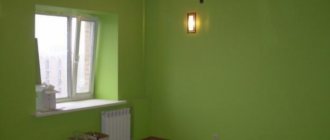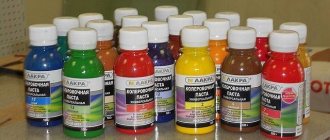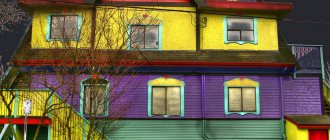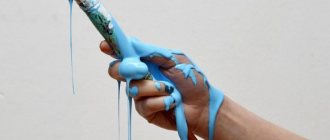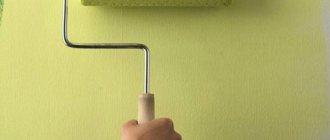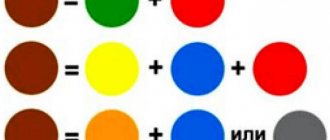It seems that it is not difficult to dilute the tint in water-based paint. But there are subtleties in the work that you need to know. In addition, the correct color choice for water-based paint will help create a dye that will be in harmony with the interior. Ready-made paints and varnishes are not always suitable for implementing the owners’ plans.
Application of paint colors
Kohler is a highly concentrated coloring agent used to obtain absolutely any shade of paint of all types. Kohler is a lifesaver if the desired ready-made shade of paint is not available. You just need to correctly calculate the proportions, and the paint of any desired shade is ready.
Only with the help of color, having only one base, you can create harmonious transitions of one shade or take risks and combine contrasting bright colors. The intensity and saturation of color depends only on a person’s imagination.
Indeed, the color scheme is capable of realizing any, even the most daring, fantasies in the interior! Tinted paints are used on the following surfaces:
- plastered walls;
- brickwork;
- concrete surfaces;
- plasterboard surfaces;
- any wooden surfaces;
- plywood;
- wallpaper for painting.
The colors are also used for outdoor use due to their resistance to external factors.
What tools are needed?
To paint walls, you need to prepare a tool. To work you will need:
- Roller. Differs in the type of cylinder. For example, the polyamide version boasts a long service life and uniform application. Fur allows you to save paint, but sometimes they leave lint on the wall. Velor ones apply an even layer, but have a high consumption. Fabric ones can splash the composition.
- Plastic pallet.
- Sanding block for surface grinding.
- Brush. Used to treat hard-to-reach places.
- Masking tape. For sealing surfaces that do not need to be painted.
- Film. Needed to protect furniture and floors from paint.
The advantage of tinting over ready-made paint
By mixing the color with paint, you can optionally obtain the entire palette of shades, from delicate to bright and catchy. Perhaps this is its main advantage. After all, the choice of ready-made tint paints in stores is not so great.
The undoubted advantages of tinting also include the following:
- application for different types of surfaces from concrete to wood;
- the ability to correct defects in the first layer of paint: by changing the color intensity, you can lighten or darken the unsuccessful layer;
- the ability to obtain many harmonious shades of the same color: not a single ready-made paint can cope with this task and will not convey the entire palette and variety of shades;
- indispensable if you choose the wrong shade of paint or if it is not available in stores;
- ease of mixing manually or using a computer program: in fact, even a child can do it;
- ease of obtaining the desired shade.
A little about choosing a room design
There are two design options:
- Thoughtful design and the right choice of paint for walls should match your character, worldview and habits. You can design rooms that are similar to each other.
- The second option is that all rooms can vary significantly if the palette of paint colors for the walls is chosen correctly.
Today, the use of paints, especially luminous ones, is considered especially fashionable when decorating a room.
All that remains is to select the right colors for the walls, learn how to prepare paints, and paint the rooms correctly.
Types of colors by composition and release form
On store shelves there is a huge selection of organic and synthetic colors of different types and consistencies, from universal to highly specialized colors. Some colors are universal, while others are intended only for certain jobs. Some colors will make the surface matte, others will make it shiny, and others will be covered with mother-of-pearl.
Pigments for paints
Pigments are finely ground powders of artificial and natural origin of different shades. They are obtained from the oxide and calcination of metals, minerals, as a result of complex chemical reactions, as well as from various plants and animals.
It is necessary to take into account that synthetic pigments are more durable and resistant to fading than organic ones. Therefore, you should choose only pigments of synthetic origin for outdoor work.
The pigments are quite cheap and this is their plus, but the number of their shades is small compared to other colorants. The loose texture of pigments often makes it difficult to regulate their penetration into the base.
Paint color
Color paint is a liquid concentrated color filler for a light or transparent base. Perhaps the most convenient to use due to its consistency. By mixing the tinting paint and the base, you can get any desired shade.
On the display cases there are colors for different purposes:
- for woodworking;
- for water-based bases;
- for enamel and varnishes.
It is better to purchase tinting paint and base from the same series; they have ideal compatibility and degree of coloring.
Tinting paste
A special feature of the paste is its use only as a color additive to the base (enamel, varnish, acrylic and water-based paints), but not separately from it, since it contains a minimum of binding components. In this case, tinting paste is inferior to tinting paint.
But the advantage of the paste is that when it gets into the base, it does not ultimately form lumps and a film on its surface. The pastes do not dry out and have a long shelf life; they are not afraid of frost, precipitation, sun rays and poor ecology. Coloring pastes can be used on any surface; they are simple and versatile to use.
Preparing the premises
Before you start painting, it is important to prepare the room. Do the following:
- Remove the curtains.
- Move all the furniture to the center of the room and cover it with film.
- Cover windows, doors and other elements with the same film, and then secure with masking tape. They will also cover the hatches and baseboards.
- Turn off the power supply circuit breakers.
- Remove the covers of switches and sockets, and then cover the electrical parts with masking tape.
- Remove heating radiators. First close the valves, unscrew the nuts and drain the water into a specially prepared pan.
After completing the above work, proceed to painting work.
Choosing a color depending on the paint base
The choice of color directly depends on the paint base. In a hurry or simply due to inattention, you can mix a color and base that do not match the characteristics and get a disastrous result. That is why you need to know that each base has its own color scheme.
Color for water-based paint
When choosing a color for this type of paint, you can purchase a color paste for universal use. It is easy to use, but requires good mixing with the base to avoid different shades when painting.
It is worth giving preference to colors marked “for water-based” or “for water-dispersion bases.” Silicone and latex paints have a composition similar to water-based paints. That is why colors marked “for silicone” and “for latex” are also suitable.
Color for acrylic paint
Acrylic paint can be tinted using a concentrate in the form of liquid, paste or powder.
The main feature of colors for acrylic paint is that they are made on a water or water-polymer basis, and the final shade when dried will be paler than in liquid form. Therefore, the most important thing is to see pre-dried samples of the paint palette and purchase the base and color of the same brand.
You need to know that the amount of color in acrylic paint cannot exceed 8% of the total volume of the base.
Color for oil paint
The most important thing when tinting oil paint is not to overdo it with the color. Its content should be no more than 15%.
Both pastes and paint colors are widely used in tinting oil-based paints.
Is it possible to paint a wall surface?
To paint a small fragment of a wall, you can use a color scheme. The use of such a product over large areas is irrational for two reasons:
- Big expense . The product is sold in small containers. In terms of regular paint it turns out to be very expensive.
- Poor application . This reason is due to the density of the composition. For drawing small and clear details this will be a plus, but for painting large surfaces it will be a minus.
Compatibility with other compounds
Colorants are distinguished by excellent compatibility not only with paints, but also with other compositions. They add special shades to varnishes and are suitable for water-based paints, alkyd paints, enamels and even whitewash. Pearlescent or metallic colorants can also be mixed with any base.
Color for facade paint
For facade paint, powder, liquid, and also colors for oil paint are equally suitable. The most important thing is maintaining proportions and mixing thoroughly in good lighting.
You should choose color compositions that are resistant to sunlight and weather conditions.
Color for wood varnish
You can tint the varnish with a universal colorant to slightly darken or give the wood the desired shade. The most important thing is the compatibility of the color with the varnish and what base this varnish is on, otherwise the resulting composition will not be able to be used in work.
It should be taken into account that for outdoor work you should choose a color with inorganic pigments, because its durability is much higher.
Color for cement
The most popular color for cement mortar is iron - an oxide color with high color saturation and durability. The composition for painting cement must be moisture resistant, not fade in the sun and be insensitive to alkalis.
Color for concrete
Colorants for concrete come in the form of paste, powders, emulsions and capsules made from natural and synthetic raw materials. As with cement colors, the main requirements are high color intensity, resistance to alkalis and sunlight, and oil resistance.
The less oil, the higher the durability of the pigment.
Color for plaster
To paint plaster, you can use pigment or liquid color. The pigment for plaster is poured into the dry mass and mixed, and the liquid color is poured into the plaster during the process of dissolving it.
Color for decorative plaster
Any decorative plaster can be tinted using tinting paste. For outdoor work, it is worth choosing UV-resistant compounds, taking into account operating conditions. And for interior work, less toxic water-based colors are chosen.
Tinting methods
Colorants are mixed with the base in two ways, which have proven equally effective.
Computer mixing method
A special computer program with a huge variety of shades will calculate the optimal proportions and promptly provide the correct composition to obtain the desired result. This does not require any independent calculations and makes the task of mixing several shades easier.
The program allows you to accurately repeat the composition if the need arises.
The only disadvantage of this method is the impossibility of working on site.
Manual mixing method
You need to focus on various recipes and a color mixing table, but the result may well be affected by the brand of the base and the shade of the color itself.
For mixing you need quite large clean containers, a base and the color itself. If there is a recipe, you need to follow it carefully. Otherwise, there is a risk of getting a completely unexpected shade, appearing completely different on the surface. And you will have to come to terms with it and work with what you have, or run for new paint and spend extra money and nerves.
If there is no recipe, then you need to write down all the proportions so that the resulting color can be reproduced again as accurately as possible. It is better, however, to stock up on paint with at least a 20% reserve.
How to repeat the color when re-tinting:
This method is accessible and inexpensive, and the composition can be mixed right where the work is being done.
The disadvantages of this method are the heterogeneity of the resulting composition and the difficulty of repeating the desired shade. It is not always clear in what proportions to mix colors to create the desired unique tone.
Cleaning the instrument
The final step is to clean the instrument. To do this, squeeze the paint roller out, rinse it and dry it. If a water-based composition was used, the water can be drained into the sewer. In other cases, gasoline or another solvent will be required, so you cannot drain the liquid into the toilet or sink.
If you need to pause while working, place the roller in the bag and close it tightly. Alternatively, use cling film. This method is suitable for a break of no more than two to three hours.
Rinse brushes and tray in warm water. In the future, the brush will need to be placed in warm water for preparation. If you don’t want to wash the tray, wrap it in foil or a bag.
Step by step instructions below
Below the tinting process in different ways is presented step by step.
How to work with a table
Working with the table is easy and understandable. You need to find the desired color and mix the paints according to the instructions in the instructions to get the desired color. The most important thing is to add colorant to the base gradually and constantly check the result on a test surface.
It would be correct to wait for it to dry completely. The ideal color will come with experience and development of color perception. There is only one principle: the selected color is compared with the shade in the table.
How to work with a palette correctly
To create a range of shades, you need basic colors, brushes, water, and a palette for mixing colors.
White is applied in the center for lightening, and dyes are applied in the remaining recesses. Next, color is added to the white in small parts. The result is checked with brush strokes. Don't forget to rinse your brush in water after each stroke.
Coloring stages
Painting walls is divided into several stages:
- Preparing the wall surface : leveling, eliminating defects with putty. Then the entire surface is sanded with sandpaper and covered with 1-2 layers of primer. Read about how to perfectly putty and evenly paint walls.
- The stage of preparing the color and mixing the paint . It is discussed in detail above.
- Wall painting stage .
For work, a roller with a fur coat is used. Its optimal size is 15-18 mm. You will need a bath and a small brush. Each time you pour paint into the tray, you must thoroughly stir the main volume of paint in the bucket. The pigment gradually settles to the bottom. If you do not stir regularly, you will end up with a darker shade than you started with. Painting begins from the corner of the room: the corner itself is painted with a brush, and the surface is treated with a roller at a distance of 5-10 cm on both sides of the corner. All stripes are applied vertically, overlapping. If painting is done over wallpaper, then the joint of the wallpaper and the joint of the coloring compound should not match. - Drying stage . It takes about 5 hours. More precise recommendations are indicated on the packaging. Subsequent layers are applied only after the previous one has completely dried.
We invite you to watch a video about the stages of painting a wall:
Review of the most popular colors
Today in the construction market there is a huge selection of color shades from Russian and foreign manufacturers. All of them have proven themselves due to their quality, fairly affordable prices, and convenient tinting systems for wide application. It is thanks to them that each brand guarantees complete color matching.
Characteristics of famous colors
Below are the main characteristics of famous colors.
Tikkurila
This well-known brand produces colors, pigments and pastes of various volumes and purposes based on varnish and colorful chemical compositions. The brand also offers its customers several lines of colors for carrying out different jobs on different surfaces.
Tex
Tex brand colors and pigments are available in 100 ml packs. The colorants are universal: suitable for oil, water-based paints, enamels and are available in 22 shades. They are used for all types of work, including outdoor ones, due to their frost resistance and light resistance.
The company's composition uses foreign pigments; modern German equipment is used in production.
An important fact about Tex paste is that it should not contain more than 10% of the total base volume. But at the same time, all the company’s pastes are universal and suitable for all bases and jobs.
Aqua Color
The colors of this St. Petersburg manufacturer are used for tinting not only different types of paints (oil-based, alkyd, water-based paints), but also cement, lime mortars, joints and grouts.
Suitable for interior and facade work. Colorants from this company combine high quality and affordable prices.
Rogneda
The tinting paints of this Moscow brand are suitable for working inside various rooms:
- independent use for decoration
- applying ornaments
- painting and other decoration of various details
The colorants from this company have exceptionally bright colors and are ideal for fine artistic work.
Rogneda colors are also successfully used outside:
- they are weather resistant
- UV resistant
- saturated are suitable for tinting different types of materials and for working on different surfaces
They are successfully used for painting plasters and water-based paints and have a high degree of adhesion.
How to choose?
The modern construction market offers a fairly large assortment of colors that are suitable for various types of paints. Some manufacturers produce pigmenting compositions that are versatile. These varieties can be used to add color to paint, plaster or putty mixture. This versatility is especially appreciated in the construction industry.
A wide assortment leads to the fact that the consumer is faced with a difficult choice. It is necessary to choose one color or another based on what surface you plan to paint.
Let's look at the different types of colors and what surfaces they are recommended for:
- The liquid version is suitable for a variety of impregnations and primers. It can be added to varnishes that are used to treat solid wood. It is also used for various lumber.
- Concentrates with a liquid consistency are designed for emulsion and disperse paints. Therefore, they are suitable for that basic base, which is made with water.
- Colors in paste form can be purchased for alkyd and oil enamels. They can be used in various mixtures for whitewashing.
- Universal materials can be used for different types of enamels.
- The composition of the color, supplemented with mother-of-pearl or metallic luster, is characterized by a different list, which allows you to select it for different paintwork materials.
